 Fukumanen is a restaurant where you can taste Shanghai, Fujian, Hunan cuisine, etc. (*depends on the restaurant) along with authentic Sichuan cuisine.
Fukumanen is a restaurant where you can taste Shanghai, Fujian, Hunan cuisine, etc. (*depends on the restaurant) along with authentic Sichuan cuisine.
→★For details, please refer to the ""Chinese Cuisine Distribution Map"" section below.
Sichuan cuisine is famous for its hot and spicy taste, but authentic Sichuan cuisine is not only spicy but also has a distinctive umami tastes. To create this flavor, in addition to the ""La"" (hot and spicy) of the Sichuan red chili peppers and the ""Ma"" (numbing) of the Sichuan pepper, many other spices are used to create a distinctive umami tastes.
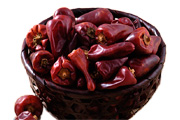 【Sichuan Red Chili Pepper】
【Sichuan Red Chili Pepper】
Also known as "chao tian la jiao" (朝天辣椒) in Chinese, this chili pepper is an essential ingredient in Sichuan cuisine and produces hot and spicy taste that is sure to give you a buzz. In Chinese, the word "chao" means to go toward, and "tian" means sky. It is called "chao tian" because it is a chili pepper that grows toward the sky. Its size is one size smaller than a small Japanese bell pepper, and it is characterized by its hotness and strong chili scent.
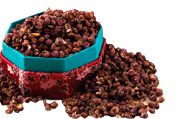 【Sichuan Pepper】
【Sichuan Pepper】
In Chinese, it is called huajiao (花椒), which is expressed as ""Ma"" (麻).
Like Sichuan Pepper, it is an essential spice in Sichuan cuisine that produces hot and spicy taste that makes your tongue to feel numbness and tingling. In Sichuan cuisine, it is generally used in combination with La (辣) "Sichuan red chili pepper", described above, and is always used in the very hot Sichuan dishes that have the word "Mala" (麻辣) in the name of the dish.
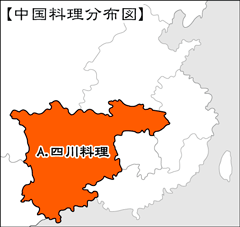 【Sichuan cuisine, one of the four major cuisines of China】*Served at all restaurants
【Sichuan cuisine, one of the four major cuisines of China】*Served at all restaurants
Sichuan cuisine has developed in the inland regions of China, including the Yunnan and Sichuan regions. These regions have large basins and are blessed with an abundance of agricultural products. The inland climate with its extreme heat and cold variations has led to the development of food preservation and storage methods. The famous Sichuan Zha Cai Pickles are a specialty of this region. The region's cuisine is also characterized by the use of many spices and condiments to suit the climate, and by the rich and pungent flavors of its dishes.
Typical dishes are Chen Mapo Tofu and Sichuan-Style Beef in a Spicy Hot Sauce, which are made with Sichuan red chili peppers and Sichuan pepper.
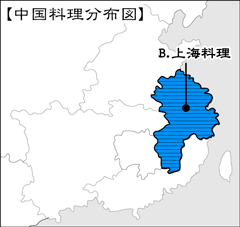 【Shanghai cuisine, one of the four major cuisines of China, with a rich international flavor.】*Shanghai cuisine, one of the four major cuisines of China, with a rich international flavor.
【Shanghai cuisine, one of the four major cuisines of China, with a rich international flavor.】*Shanghai cuisine, one of the four major cuisines of China, with a rich international flavor.
Shanghai cuisine has developed in Shanghai and the surrounding areas of Suzhou, Hangzhou, and Yangzhou in eastern China, where there are many rivers and lakes and close to the sea. The region is rich in fresh seafood and is a major rice-producing region in China. In addition to seafood, many dishes are made with rice as an ingredient. In Shanghai, a well-known international trading port, the cuisine also incorporates excellent cooking methods from outside the country, such as serving dishes that take into account the color of the ingredients. Shanghai cuisine, depending on the region, is characterized by relatively strong, oily, and sweet flavors, with a lot of sugar use.
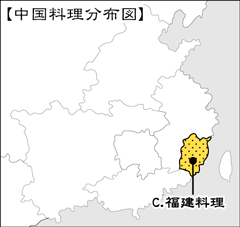 【Fujian cuisine, known as the roots of Okinawan cuisine】*Served at Honten
【Fujian cuisine, known as the roots of Okinawan cuisine】*Served at Honten
Fujian cuisine has developed mainly in the Fujian Province of eastern China near Shanghai. The region is facing the sea and rivers, where fresh seafood is abundant. It is also adjacent to Taiwan and close to Okinawa, so it is said that the flavor of Fujian cuisine was introduced across the sea and influenced Okinawan cuisine in many ways. Fujian cuisine is characterized by the addition of unique seasonings such as fermented bamboo shoots and small fish extract, which add strong flavors to the light taste of the ingredients.
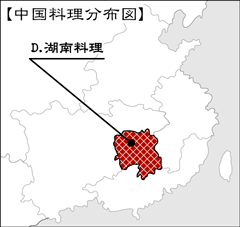 【Hunan cuisine, characterized by a spiceness that surpasses Sichuan cuisine】*Served in the annex building.
【Hunan cuisine, characterized by a spiceness that surpasses Sichuan cuisine】*Served in the annex building.
Hunan cuisine has recently come into the spotlight as the fifth cuisine after the four major Chinese cuisines (Beijing, Shanghai, Cantonese, and Sichuan). Although included in Sichuan cuisine in the broadest sense, Hunan cuisine is said to be even hotter and spicier than Sichuan cuisine. It is a cuisine that practices the "medicine and food share the same origin," which is said to be the origin of food, in daily life. Because the Hunan region does not face the sea, the food is characterized by savory, hot, and sour flavors, such as pickles and hot and spicy seasonings that help preserve ingredients. Hunan is also famous as the birthplace of the late President Mao Zedong.